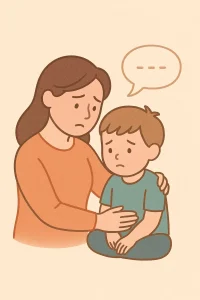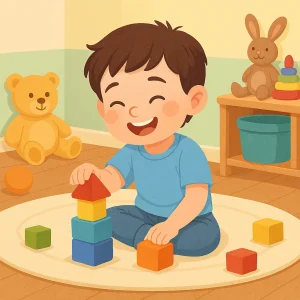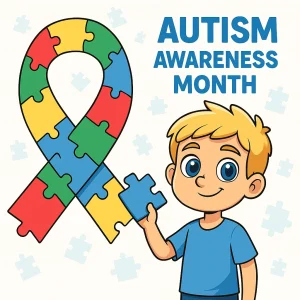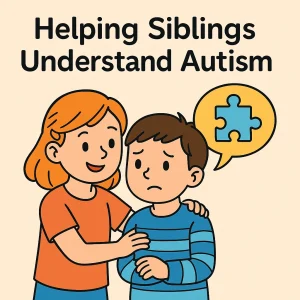Understanding Speech Patterns in Autism
By Rajini D
Last Updated: March 15, 2024
Autism Spectrum Disorder (ASD) touches the lives of many families around the world, shaping the way individuals communicate, learn, and interact with others. At its core, autism influences not just the ability to speak but also the unique patterns in which words are delivered and understood. These speech patterns can sometimes become barriers to connection, understanding, and support within communities and families.
But what if we could bridge this gap? Imagine a world where we’re all a bit more fluent in the language of autism, where speech patterns are not obstacles but keys to deeper connection. This guide aims to do just that—shed light on the intricate speech patterns characteristic of autism in a way that’s easy to grasp, deeply relatable, and, above all, practical.
Through simple language and clear examples, we’ll explore the common speech patterns in autism, why they’re important to recognize, and how understanding them can significantly enhance our support for individuals with ASD. This journey of understanding starts with the basics—defining what these speech patterns are and how they impact communication. But it’s more than just information; it’s about creating a bridge of empathy and support across the spectrum of autism.
What Are Autism Speech Patterns?
Defining Autism Spectrum Disorder (ASD)
Autism Spectrum Disorder, or ASD, is like a kaleidoscope of human experience, where each twist and turn reveals a unique pattern of thoughts, behaviors, and interactions. This diversity is why we use the term “spectrum” to describe autism, highlighting the wide range of differences and abilities seen in individuals with ASD. One person with autism might have remarkable artistic or mathematical skills, while another might face challenges in social communication or sensory processing.
Common Speech Patterns in Autism
Diving into the world of autism, we encounter a variety of speech patterns that might seem unusual at first but are simply different ways of experiencing and expressing language. Let’s explore a few:
- Echolalia: This is when an individual repeats words or phrases they’ve heard, almost like an echo. It might serve various functions, such as self-regulation or communication.
- Pronoun Reversal: Some individuals might say “you” instead of “I” or vice versa. It’s a unique way of processing and expressing thoughts.
- Monotonous Speech: A speech pattern that lacks the usual ups and downs in tone. It might come across as flat or robotic, but it is simply another form of verbal expression.
- Literal Interpretation: Taking words and phrases at face value, individuals with autism might find idioms or metaphors confusing, preferring clear, direct language.
These speech patterns are windows into how individuals with autism process information and interact with their environment. Recognizing and understanding these patterns are crucial steps toward effective communication and support.
Comparison of Typical vs. Autism Speech Development Stages”
| Age Range | Typical Development Milestones | Autism Spectrum Differences |
|---|---|---|
| 6 months | Babbling, making sounds that can include p, b, m | Limited or no babbling, may not respond to their name or sounds |
| 12 months | Saying single words like “mama” or “dada,” responding to their name | Possible lack of spoken words, may not point at objects or show interest in communicating |
| 2 years | Combining two words to form simple sentences, recognizing names of familiar objects | Limited use of two-word phrases, might rely on echolalia, less likely to initiate conversations |
| 5 years | Using full sentences, understanding simple stories, recognizing colors and shapes | Difficulties with back-and-forth conversation may have unusual tone or rhythm in speech and challenges with understanding abstract concepts. |
The Impact of Autism on Communication
Challenges in Social Interaction and Communication
Autism profoundly shapes how individuals perceive and engage with the world, particularly affecting both verbal and non-verbal communication. These differences can lead to unique challenges in social interactions, an essential aspect of everyday life. Understanding these autism communication challenges helps us appreciate the nuances of navigating social contexts with autism.
Verbal communication, for instance, involves more than just words; it’s about timing, tone, and the flow of conversation. Individuals with autism might find these aspects challenging, leading to conversations that may seem one-sided or lacking in engagement from a neurotypical perspective. This is not due to a lack of interest or empathy; rather, it’s a reflection of the diverse ways in which people with autism process and express language.
Non-verbal communication includes gestures, eye contact, facial expressions, and body language—unspoken elements that enrich our conversations. For someone on the autism spectrum, these signals might be less intuitive, making it harder to read others’ emotions or intentions or to express their own feelings in ways that are easily recognized by those around them.
Understanding Through Examples
To bridge the gap in understanding, consider the following scenarios:
- Example 1: At a family gathering, Alex, who is on the spectrum, avoids making eye contact and doesn’t join in the laughter. Instead of interpreting this as disinterest, understanding autism means recognizing that Alex processes social cues differently and may express joy in other ways.
Reflective Question: Have you noticed moments when someone’s response seemed out of sync with the conversation’s emotional tone? How might understanding autism change your perception of these moments? - Example 2: In school, Jamie, a child with autism, repeats phrases from her favorite cartoon rather than answering questions directly. This echolalia isn’t just mimicry; it’s a way of communicating within Jamie’s comfort zone.
Reflective Question: Can you recall a time when someone used repetitive phrases in conversation? How could recognizing this as a communication strategy change the way you interact?
How to Support Communication Development
The Role of Speech Therapy
Speech therapy plays a pivotal role in unlocking the world of communication for individuals with autism. It’s not just about teaching words or correcting pronunciation; it’s a comprehensive approach that fosters the ability to express thoughts, needs, and emotions effectively and to understand others. Speech therapists employ a variety of techniques tailored to each individual’s needs, ensuring that therapy is a supportive, engaging, and enriching experience.
Some techniques include:
- Play-based therapy: Utilizes play to encourage the development of speech and language skills in a natural setting.
- Picture Exchange Communication System (PECS): Helps individuals communicate using pictures.
- Social stories and role-playing: Aids in understanding and practicing social interactions.
- Augmentative and Alternative Communication (AAC): Uses devices or systems to help those who are non-verbal to communication.
Strategies for Supporting Communication in Children with Autism
| Strategy | Description | Implementation Tips |
|---|---|---|
| Visual Supports | Using pictures, symbols, or objects to aid communication. | Start with simple pictures to represent daily activities; gradually introduce more as the child becomes comfortable. |
| Play-Based Learning | Encouraging communication through interactive play. | Choose toys and games that require turn-taking and use this as an opportunity to model phrases and encourage verbal exchange. |
| Social Stories | Short descriptions of a particular situation, event, or activity, including specific information about what to expect in that situation and why. | Tailor social stories to the child’s experiences; use them to prepare for new activities, social interactions, or to teach new skills. |
| Speech-Generating Devices (SGDs) | Electronic devices that allow the user to select symbols, pictures, letters, or words to generate speech. | Work with a speech-language pathologist to select appropriate devices and software that match the child’s needs and abilities. |
| PECS (Picture Exchange Communication System) | A form of AAC that uses pictures to teach communication skills. | Start with basic requests and gradually introduce more complex concepts like commenting and answering questions. |
| Encourage Imitation | Teaching language skills by modeling and encouraging the child to imitate actions, sounds, and words. | Use daily routines as opportunities for imitation, such as saying “bye” when leaving a room or mimicking animal sounds during play. |
| Reinforce Efforts | Positively reinforcing attempts at communication, regardless of how imperfect they may seem. | Offer praise, smiles, or a preferred activity or item as reinforcement for communication attempts to encourage further efforts. |
Practical Tips for Parents and Caregivers
Supporting communication development at home is crucial and complements the work done in therapy sessions. Here are some practical tips for parents and caregivers to foster an environment that encourages speech and language growth:
- Create a Communication-Friendly Environment: Engage in activities that naturally encourage communication, like reading together or playing interactive games. Use clear, simple language, and give your child time to respond.
- Use Visual Supports: Visual schedules, choice boards, or flashcards can help make communication more tangible and understandable.
- Celebrate All Forms of Communication: Recognize and respond to non-verbal cues, such as gestures or facial expressions, showing that all attempts at communication are valued.
- Incorporate Their Interests: Talk about topics they’re passionate about. This not only holds their attention but also encourages them to participate in the conversation.
- Be Patient and Positive: Encourage attempts at communication with positivity and patience. Every effort, no matter how small, is a step forward.
- Model and Repeat: Use language modeling by speaking at a slightly higher level than your child’s current communication skills and repeat back what they say in a more complex form to build on their language.
Conclusion
This guide has been more than just an exploration of challenges; it has been an opportunity to celebrate the diverse perspectives and strengths individuals on the spectrum bring into our lives. Our primary aim was to simplify complex information about autism’s speech patterns, making it both accessible and relatable, thereby equipping families, educators, and caregivers with knowledge and strategies to foster meaningful connections.
Embracing the diversity in communication styles not only enriches our communities but also underscores the value of inclusivity. By continuing to educate ourselves and support those with autism, we create a world where every voice is heard and valued. We encourage you to remain engaged in this journey, share your insights, and seek out supportive communities like Wellness Hub, where resources and understanding flourish. Together, we can ensure a more inclusive future for individuals on the autism spectrum.
Frequently Asked Questions:
1. What are speech patterns in autism?
Speech patterns in autism refer to the unique ways individuals with autism spectrum disorder (ASD) communicate, including differences in tone, pitch, rhythm, and the use of language. These patterns can include echolalia (repeating words or phrases), pronoun reversal, monotonous or flat speech, and literal interpretation of language.
2. How can speech therapy help children with autism?
Speech therapy can be incredibly beneficial for children with autism by improving their communication skills, including speech, language development, and non-verbal communication. Therapists use a variety of techniques tailored to each child’s needs, such as play-based therapy, Picture Exchange Communication System (PECS), social stories, and augmentative and alternative communication (AAC) devices.
3. What practical tips can parents and caregivers use to support communication development in autism?
Parents and caregivers can support communication development by creating a communication-friendly environment, using visual supports, celebrating all forms of communication, incorporating interests into conversations, modeling language, and being patient. Engaging in activities that encourage interaction and understanding the child’s unique way of communicating are key.
4. Why is understanding and accepting autism speech patterns important?
Understanding and accepting autism speech patterns are crucial for fostering effective communication, empathy, and meaningful connections with individuals with autism. It helps in creating supportive environments that respect and value the unique perspectives and abilities of individuals on the spectrum, enhancing their social integration and quality of life.
5. How can communities be more supportive of individuals with autism?
Communities can be more supportive by promoting awareness and understanding of autism, including speech patterns and communication challenges. Educating the public, creating inclusive spaces, offering support and resources to families, and celebrating the achievements and individuality of people with autism are ways to build a more accepting and supportive community.
6. Where can I find more resources on supporting individuals with autism?
Wellness Hub offers a wide range of resources, support, and information for families navigating autism. From detailed guides on communication strategies to support groups and educational materials, Wellness Hub is committed to helping individuals with autism and their families find answers and community support.
7. Can speech patterns predict autism spectrum disorder?
While speech patterns alone cannot diagnose autism spectrum disorder (ASD), they are significant indicators used alongside other behavioral and developmental assessments. Early identification of unusual speech patterns, such as lack of babbling in infants, echolalia, or atypical prosody in toddlers, can prompt further evaluation for ASD and early intervention.
8. How do autism speech patterns differ from typical speech development?
Autism speech patterns often differ significantly from typical speech development in several ways, including delayed speech or language skills, echolalia (repeating words or phrases heard), pronoun reversal, limited use of gestures, unusual tone or rhythm, and difficulty with conversational turn-taking. These differences highlight the unique ways individuals with autism process and use language.
9. Are there any technological aids to support communication in autism?
Yes, there are various technological aids designed to support communication in individuals with autism. Augmentative and alternative communication (AAC) devices, speech-generating devices, and applications tailored for ASD can facilitate communication, especially for non-verbal individuals or those with limited speech. These technologies provide alternative means to express needs, desires, and thoughts.
10. How can schools support students with autism and their unique speech patterns?
Schools can support students with autism by providing individualized education plans (IEPs) that include speech and language therapy as needed, training staff and teachers about autism and effective communication strategies, creating inclusive classrooms that accommodate diverse learning and communication styles, and fostering a supportive environment that encourages all students to understand and accept differences in speech patterns and communication.
About the Author:
Rajini Darugupally
M.Sc., Speech-Language Pathologist (9+ years of experience)
Rajini is a passionate and dedicated Speech-Language Pathologist with over 9+ years of experience, specializing in both developmental speech and language disorders in children and rehabilitation in adults. Driven by a desire to empower each individual to find their voice, Rajini brings a wealth of experience and a warm, genuine approach to therapy.
Currently, at Wellness Hub, she thrives in a team environment that values innovation, compassion, and achieving results for their clients.
Connect with Rajini to learn more about how she can help you or your loved one find their voice.
Book your Free Consultation Today
Parent/Caregiver Info:
Client’s Details:
* Error Message









